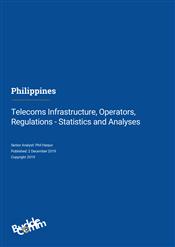Philippines - Telecoms Infrastructure, Operators, Regulations - Statistics and Analyses

Last updated: 2 Dec 2019 Update History
Report Status: Archived
Report Pages: 57
Analyst: Sebastien De Rosbo
Synopsis
A substantial amount of capital continues to be invested in building telecommunications infrastructure throughout the Philippines.
Telecommunications investment in the Philippines will continue to see increasing emphasis on supporting high speed broadband access. The bulk of the fixed services are in urban areas. In contrast, the fixed line market in the Philippines remains underdeveloped and fixed line penetration continues to show stagnant growth. A major reason for this is due to the dominance of the mobile segment and the rapid expansion of the mobile broadband segment.
Despite competition from new carriers and mobile operators, PLDT has continued to be the Philippines’ dominant fixed-line provider. However, in recent years, Globe Telecom in particular has been pushing hard to overhaul the incumbent and now is the leading mobile provider in term of overall subscribers.
In 2018 the Department of Information and Communications Technology (DICT) published its guidelines to accommodate the entry of a third major telecoms operator in the local market.
Over the past five to ten years and particularly more recently over the past two years there has been significant new data centre builds and additions to existing capacity as new providers enter the South East Asian data centre market. More and more people are getting online and using cloud computing services, driving demand for data centres services.
The Philippines government passed a Bill which seeks to provide for an online network establishment (ONE) policy for the country to reduce the digital divide and accelerate the rollout of more wireless communications technology across the country.
In recent few years, the major operators have also been forced to cope with the pressures of slowing growth in traditional areas of the market and rising investment needs for new growth areas in such as consumer broadband – both fixed line and mobile. In particular, there has been good progress in the rollout of optical fibre infrastructure. PDLT announced plans to accelerate a network modernisation plan that will see it switching to fibre over the following two years.
Key developments:
- Telecommunications investment will continue to support high speed broadband access.
- The Philippines data centre market has seen rapid recent growth.
- Globe Telecom is now challenging PLDT in both the fixed and wireless markets.
- In 2019/2020 an important telecoms development is occurring for the Philippines with the launch of the Kacific-1 satellite.
Companies mentioned in this report include:
PLDT, Smart Communications, Globe Telecom, Liberty Telecom, Bayantel, Bell Telecom (BellTel), Digitel, Eastern Telecom (ETPI), Innove (Globe), PT&T, ABS-CBN Corp.
Related Reports
- Philippines - Telecoms, Mobile and Broadband - Statistics and Analyses
- 2019 Asia - Mobile Network Operators and MVNOs
- 2019 Asia - Fixed Broadband Market - Statistics and Analyses
- 2019 Asia - Mobile Infrastructure and Mobile Broadband
- Cambodia - Telecoms, Mobile and Broadband - Statistics and Analyses
- Laos - Telecoms, Mobile and Broadband - Statistics and Analyses
- Singapore - Telecoms, Mobile and Broadband - Statistics and Analyses
- Armenia - Telecoms, Mobile and Broadband - Statistics and Analyses
- Timor Leste (East Timor) - Telecoms, Mobile and Broadband - Statistics and Analyses
- Uzbekistan - Telecoms, Mobile and Broadband - Statistics and Analyses
Share this Report
TMT Intelligence
A platform to scale your intelligence tasks
Monitor critical insights with our AI-powered Market Intelligence Platform gathering and analyzing intelligence in real time. With AI trained to spot emerging trends and detect new strategic opportunities, our clients use TMT Intelligence to accelerate their growth.
If you want to know more about it, please see:
Research Methodology
BuddeComm's strategic business reports contain a combination of both primary and secondary research statistics, analyses written by our senior analysts supported by a network of experts, industry contacts and researchers from around the world as well as our own scenario forecasts.
For more details, please see:
More than 4,000 customers from 140 countries utilise BuddeComm Research
Are you interested in BuddeComm's Custom Research Service?
Hot Topics
News & Views
Have the latest telecommunications industry news delivered to your inbox by subscribing to BuddeComm's weekly newsletter.